The human cost of pollution
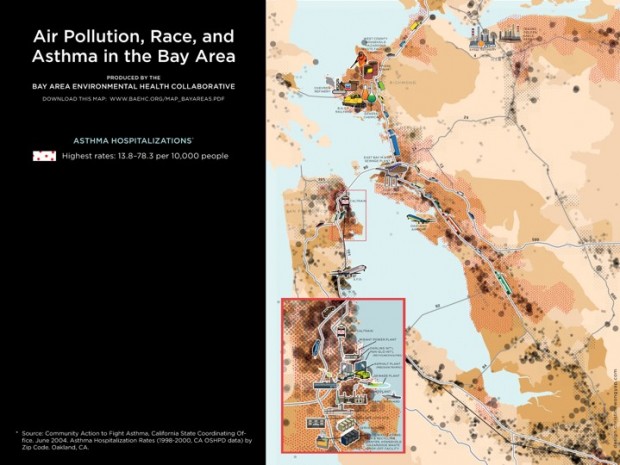
Map provided by the Bay Area Environmental Health Collaborative.
By: Kerri Connolly | October 26, 2010 –
For more info about toxics in Richmond, check out:
Voices from the Toxic Triangle
Download MP3
Audio by: Anne Brice
When Vicki Sawicki leaves her Atchison Village home, there’s often a foul tang that permeates the air.
“The pollution is so strong that sometimes you can taste it.” Sawickisaid, her face scrunching into a grimace. “It’s kind of a metallic kind of taste.”
Sawicki and several dozen other Bay Area residents met in North Richmond on Saturday at the invitation of the Toxic Triangle Coalition, founded by the Reverend Dr. Daniel Buford of the Allen Temple Baptist Church in Oakland.
The group is an effort to pull together three Bay Area neighborhoods that residents and air quality officials say have been disproportionately affected by toxic contaminants and environmental hazards. Richmond is located at the northern apex ofthe “Toxic Triangle,” with Oakland to the south and Bayview Hunter’s Point to the west.
Jack Broadbent is CEO and the Air Pollution Control Officer for the Bay Area Air Quality Management District (BAAQMD).
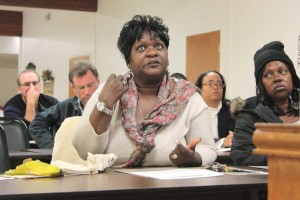
Marie Harrison came from Bayview Hunter's Point neighborhood in San Francisco for Saturday's Toxic Triangle meeting.
At Saturday’s meeting, Broadbent attributed many of the health problems experienced by members of these neighborhoods to “diesel particulate matter,” a kind of air pollutant that comes from combustion engines.
Among the majors sources of these tiny particles are moving vehicles like cars, trucks, tankers, trains, and buses. Stationary sources of particulate pollution include power plants, factories, and refineries.
Bayview resident Marie Harrison described some of the health problems she has seen in her neighborhood: asthma, cancer, heart disease, headaches, severe rashes, and nosebleeds.
Richmond has the same problems: The Bay Area Environmental Health Collaborative has collated data showing Richmond has both high levels of diesel particulate pollution and the highest levels of child asthma hospitalizations in all of Contra Costa County.
Environmental activist and Richmond resident Gwendolyn Powell sees a wide range of health problems among her neighbors and her own family.
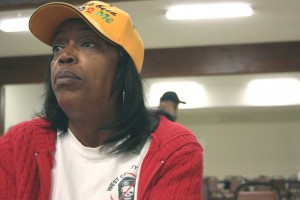
Gwendolyn Powell of Richmond often has breathing problems because of the air around her Las Deltas home.
Powell’s stepfather died in 2001, after suffering from asthma, a condition her brother also struggles with. Her cousin died from an asthma attack.
A 50-year resident of North Richmond, Powell said she’s become concerned about the health risks of living so close to the Chevron refinery.
Yet the refinery is one part of a larger problem. In each of the communities that comprise the Toxic Triangle, multiple sources of pollution are infecting the neighborhoods in compounding ways.
Bayview Hunter’s Point residents, for example, breathe emissions wafting off the 101 and 280 freeways. There are also two federal Superfund sites and hundreds of acres of contaminated brownfields from a former naval shipyard.
In addition to the Chevron smokestacks in Richmond, residents must contend with busy freeways running through the community; with a port, where diesel trucks come and go hour upon hour; and with the rail yards, where trains have been known to idle their engines for days at a time.
This infrastructure of pollution that is literally built into neighborhoods—neighborhoods where residents are largely low-income ethnic minorities—is what’s called environmental racism.
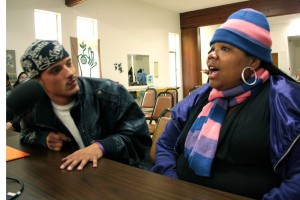
Tiana Drisker, 30, of Richmond talks with Phillip Watkins Jr, 22, at Saturday's meeting. Watkins came from Oakland for the event.
“This is not just about trash on the ground,” said Tiana Drisker. “We have been conditioned to think this is normal,” she said of the foul smells, hazy air, and history of contaminated land.
Drisker, 30, lives in Richmond. Several years ago, she became involved with Communities for a Better Environment, a California based non-profit focused on environmental health and justice.
She became so passionate about environmental health that she’s leaving behind a completed dental hygienist degree to enter an environmental program. Drisker plans to help educate her community about the risks pollutants pose to their wellbeing.
It’s time for Richmond residents to “demand accountability, demand responsibility,” Drisker said, encouraging other young people in the audience to continue to get involved and give a voice to their communities.
Mayor Gayle McLaughlin briefly attended the meeting, pledging to fight environmental injustice and noting her efforts to build bike paths and community gardens.
What Vicki Sawicki wants is a little harder than new gardens and bike trails. “I don’t want to inhale any toxic chemicals,” she said following Saturday’s meeting.
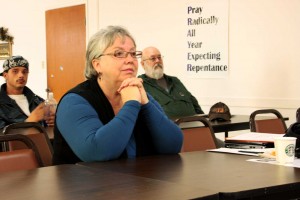
Richmond mayor Gayle McLaughlin listens to Jack Broadbent's presentation in North Richmond on Saturday.
In the ten years that Sawicki has lived in Atchison Village, several times she’s gotten the alert to “shelter-in-place,” which means to close all windows, doors, and sources of ventilation to the outside environment.
As part of Contra Costa County’s emergency response directions, residents are instructed to shelter-in-place whenever harmful levels of toxins are released in the air. “It’s scary,” Sawicki said about the alerts.
“I’m not a chemist, but I know the air is not healthy to breathe,” she continued. “We all have a right to breath clean air.”